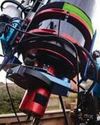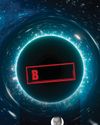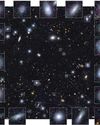
How It Works UK
HOW WAVE POOLS WORK
What technology is used to sculpt the perfect wave?
3 min |
Issue 203

How It Works UK
Winter sea ice cover is at its lowest in a 47-year satellite record
Winter sea ice cover has dropped to its lowest maximum on record as temperatures continue to exceed 1.5 degrees Celsius.
2 min |
Issue 203

How It Works UK
WHAT IS THE GREAT ATTRACTOR?
Head for the stars and discover what it is that makes the Great Attractor such a magnetic idea
6 min |
Issue 203

How It Works UK
REDISCOVERING THE DINOSAURS
They're often depicted as huge, scaly beasts, but new discoveries are changing our beliefs about the creatures that once stalked our planet
5 min |
Issue 203

How It Works UK
WHEN IS THE NEXT ICE AGE?
By following Earth's journey around the Sun, scientists are able to predict the next deep freeze
3 min |
Issue 203

How It Works UK
KITCHEN SINK CHEMICALS EXPLAINED
Every home has an armoury of liquids to combat stains and leave surfaces germ-free. But how do they do their job?
3 min |
Issue 203

How It Works UK
NATIONAL FLOWERS OF THE WORLD
Why some countries have picked beautiful blooms to represent them
5 min |
Issue 203

How It Works UK
WHAT IS THE WATER TABLE?
Get to grips with groundwater and discover where it comes from
2 min |
Issue 203

How It Works UK
'Fingerprints of cancer' found after infrared light was flashed at samples
Flashes of infrared light can detect signs of cancer in a patient’s blood. Scientists demonstrated that a test using infrared light can detect the difference between blood samples from patients with lung cancer and samples from those without the disease with up to 81 per cent accuracy.
2 min |
Issue 203

How It Works UK
WHY DO WE SLEEP?
A good night's rest is an essential part of life, but getting enough can be hard. We take a look at the science behind snoozing and how you can sleep easy
8 min |
Issue 203

How It Works UK
WHY ANIMALS PLAY
From bees playing ball to snowboarding birds, is there reason to animal recreation?
6 min |
Issue 203

How It Works UK
Lab-grown teeth could offer alternatives to implants
Scientists have gotten one step closer to growing replacement teeth in the lab, a development that could pave the way for new alternatives to unpleasant dental fillings and root canals.
2 min |
Issue 203

How It Works UK
A 'MILITARY OUTPOST' MIGHT BE THE BIRTHPLACE OF ALEXANDER THE GREAT'S GRANDMOTHER
Archaeologists may have discovered the remains of Lyncus, an ancient city that was the capital of the kingdom of Lynkestis.
1 min |
Issue 203

How It Works UK
SCIENTISTS SPOT A 'DARK NEBULA' BEING TORN APART BY INFANT STARS
A battle is raging between darkness and light in the constellation Circinus, and a new image from the National Science Foundation's Dark Energy Camera captures a key turning point in the cosmic campaign.
1 min |
Issue 203

How It Works UK
Severe drought helped bring about a ‘barbarian' invasion of Roman Britain
A severe three-year drought helped bring about a 'barbarian' invasion of Roman Britain in 367 CE, a new study finds. In that year, Roman troops stationed at Hadrian's Wall on the empire's northern frontier rebelled, and three different 'barbarian' groups invaded Roman Britain, with the Picts attacking northern Britain from Scotland, the Scoti invading western Britain from Ireland and the Saxons invading southern Britain from the European continent.
1 min |
Issue 203
How It Works UK
China's '2D' chip could soon be used to make silicon-free chips
Researchers in China say they have created a new silicon-free transistor that could significantly boost performance while reducing energy consumption.
2 min |
Issue 203

How It Works UK
Solar wind could be making water on the Moon
Constant gusts of particles from the Sun may be creating water molecules on the Moon, a new NASA-led experiment hints.
2 min |
Issue 203

How It Works UK
HOW SOY SAUCE IS MADE
This salty, traditional Chinese seasoning is the product of fermented crops
2 min |
Issue 203

How It Works UK
THE UNIVERSE MAY REVOLVE ONCE EVERY 500 BILLION YEARS
In 1929, Edwin Hubble published a paper demonstrating that the universe is expanding. It gave rise to the Hubble constant, the number that describes how fast the universe is expanding.
1 min |
Issue 203

How It Works UK
SCHOOL SCIENCE ESSENTIALS
Take a tour of a classroom laboratory and discover how your school's scientific instruments work
4 min |
Issue 203

How It Works UK
HOW ELECTRICITY GETS TO YOUR HOME
From power plant to plug socket, follow the journey electricity takes before it reaches our homes
3 min |
Issue 203

How It Works UK
Is Voyager 1 in interstellar space now?
Yes. After a 47-year journey out of the Solar System, Voyager 1 has left the heliosphere - the region dominated by particles flowing out from the Sun in the solar wind.
8 min |
Issue 203

BBC Sky at Night Magazine
Stonehenge and the Moon
Unlocking the secrets of lunar standstill
8 min |
June 2025

BBC Sky at Night Magazine
INSIDE THE SKY AT NIGHT
With the May episode of The Sky at Night looking at all things Mars, presenter George Dransfield asks why so many people are drawn to the Red Planet
3 min |
June 2025

BBC Sky at Night Magazine
The darkest skies on Earth
In search of pristine night skies and true darkness, author Paul Bogard travelled 5,000 miles to northern Chile. What he found amazed him
3 min |
June 2025

BBC Sky at Night Magazine
Goodnight Gaia!
After a decade of scientific operations, ESA's Gaia spacecraft has finally been retired
1 min |
June 2025

BBC Sky at Night Magazine
SKILLS FOR STARGAZERS
Get the best from your astro camera
3 min |
June 2025

BBC Sky at Night Magazine
Space myths BUSTED
From frozen astronauts to rampaging black holes, Alastair Gunn debunks 10 things you thought you knew about space
8 min |
June 2025

BBC Sky at Night Magazine
ZWO Seestar S30 smart telescope
Sure to tempt beginners, the S50's tiny sibling is afforable, super-simple and great fun
3 min |
June 2025

BBC Sky at Night Magazine
Q&A WITH A DWARF GALAXY HUNTER
The Euclid space telescope has only just begun its six-year-long mission to map the night sky, but it's already revealed a treasure trove of new galaxies
3 min |
